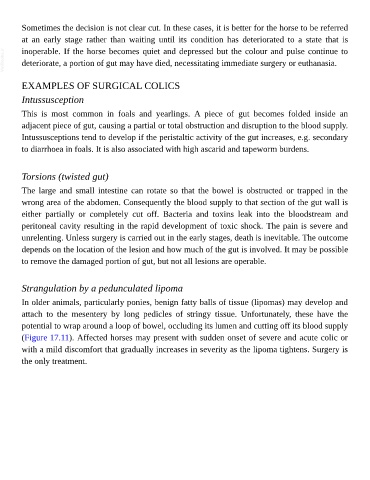Page 772 - The Veterinary Care of the Horse
P. 772
Sometimes the decision is not clear cut. In these cases, it is better for the horse to be referred
at an early stage rather than waiting until its condition has deteriorated to a state that is
VetBooks.ir inoperable. If the horse becomes quiet and depressed but the colour and pulse continue to
deteriorate, a portion of gut may have died, necessitating immediate surgery or euthanasia.
EXAMPLES OF SURGICAL COLICS
Intussusception
This is most common in foals and yearlings. A piece of gut becomes folded inside an
adjacent piece of gut, causing a partial or total obstruction and disruption to the blood supply.
Intussusceptions tend to develop if the peristaltic activity of the gut increases, e.g. secondary
to diarrhoea in foals. It is also associated with high ascarid and tapeworm burdens.
Torsions (twisted gut)
The large and small intestine can rotate so that the bowel is obstructed or trapped in the
wrong area of the abdomen. Consequently the blood supply to that section of the gut wall is
either partially or completely cut off. Bacteria and toxins leak into the bloodstream and
peritoneal cavity resulting in the rapid development of toxic shock. The pain is severe and
unrelenting. Unless surgery is carried out in the early stages, death is inevitable. The outcome
depends on the location of the lesion and how much of the gut is involved. It may be possible
to remove the damaged portion of gut, but not all lesions are operable.
Strangulation by a pedunculated lipoma
In older animals, particularly ponies, benign fatty balls of tissue (lipomas) may develop and
attach to the mesentery by long pedicles of stringy tissue. Unfortunately, these have the
potential to wrap around a loop of bowel, occluding its lumen and cutting off its blood supply
(Figure 17.11). Affected horses may present with sudden onset of severe and acute colic or
with a mild discomfort that gradually increases in severity as the lipoma tightens. Surgery is
the only treatment.

